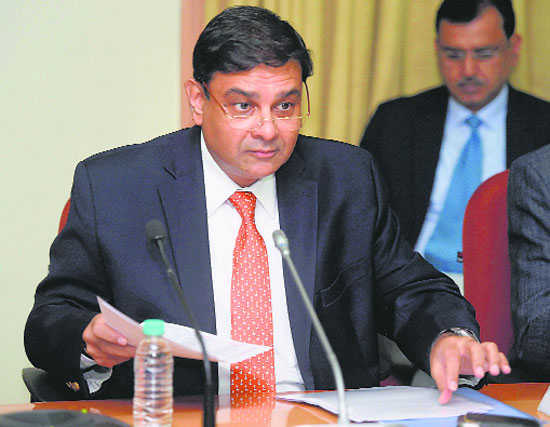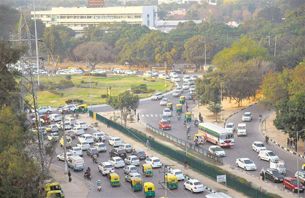
Self first: Looks like the RBI is putting its credibility ahead of the nation’s wellbeing.
Mythili Bhusnurmath
THE only good thing that can be said about the RBI’s fourth bi-monthly monetary policy statement (2017-18) is that it was entirely on expected lines. The bank was expected to keep its policy rates unchanged. It has done that! The repo rate at which the RBI provides liquidity to the system has been kept unchanged at 6 per cent. It was expected to lower its GDP estimate for 2017-18. It has done that! The country’s GDP is now expected to grow at 6.7 per cent, down from 7.3 per cent projected in the bank’s last monetary policy statement in early August.
Markets expected nothing; and got nothing. But is that good enough? Is that all we can expect from the central bank at a time when the economy is showing visible signs of stress; when far-reaching, but necessary, structural reforms such as the GST, the Insolvency and Bankruptcy Code, the Real Estate Regulatory Authority, the shift to an inflation targeting regime, etc. are still works in progress? Worse, are taking a toll on economic activity!
That is where opinion differs. Monetary purists would have it that the RBI, more correctly the Monetary Policy Committee (MPC), had no option. The recent increase in inflation rates, both at the retail and wholesale level, with consumer price inflation (CPI) moving up to 3.4 per cent in August, along with gathering storm clouds on the global geopolitical front, the danger of the union government breaching its fiscal deficit target and the possibility that the implementation of salary hikes by state governments on the lines of the Seventh Pay Commission recommendations would add to inflationary pressures are reason enough to justify the bank’s caution.
But is it really? What has changed since the bank’s last policy announcement two months ago when the RBI cut its repo rate by 25 basis points to 6 per cent? The bank has always claimed its policy actions are data-dependent. So, let’s take a look at the macroeconomic data published since August 2017 viz one GDP print, released by the Central Statistical Organisation (CSO) on August 31, 2017, two inflation data prints for July and August, two data sets for industrial production for June and July, apart from data on core sector growth and trade data.
What does the data tell us? That while inflation has moved up, it remains well within the RBI’s own medium-term target of 4 per cent. Meanwhile, growth has fallen to a six-quarter low of 5.7 per cent, suggesting it is time to shift focus to propping up growth. But all that is in the past. Monetary policy, it is claimed, must always be forward-looking so the bank must look ahead while framing its policy.
So, what does the RBI’s own reading of the tea leaves tells us? Its policy statement is clear. ‘In August, headline inflation was projected at 3 per cent in Q2 (July-September 2017) and 4.0-4.5 per cent in the second half of 2017-18. Actual inflation outcomes so far have been broadly in line with projections.’
And now for the interesting part. After listing a number of reasons why inflation could inch up, it goes on to say, ‘Taking into account these factors, inflation is expected to rise from its current level and range between 4.2-4.6 per cent in the second half of the year.’ To put that in a nutshell, according to the bank’s own estimates, inflation is projected to increase marginally: from 4.0-4.5 per cent estimated in August 2017 to 4.2- 4.6 per cent, according to its latest estimates.
In contrast, GDP growth is expected to fall sharply — from 7.3 per cent at the time of its August policy to just 6.7%, according to the bank’s latest estimates. The policy statement speaks of the ‘loss of (growth) momentum in Q1 of 2017-18, problems with implementation of GST that may delay revival of investment activity that is already hampered by stressed balance sheets of banks and corporates’.
Faced with the prospect of a nominal increase in inflation projections and a much sharper decline in growth projections, and at a time when global inflation is low even as globally growth is recovering, the choice of priorities in the growth vs inflation trade-off should have been a no-brainer. Or so anyone with an iota of commonsense would have thought. But not the MPC or the RBI!
We have, therefore, a situation where given the option of choosing between propping up growth and adopting a rigid, textbook approach to the inflation target, the MPC and RBI chose to focus on inflation control at the expense of growth. Like Banquo’s ghost, which only Macbeth in Shakespeare’s famous play of the same name could see, MPC members seem to obsess about inflation, even after it has ceased to be the bogey it once was.
Never mind that the whole idea of a ‘flexible’, as against an ‘inflexible’ inflation target, was to take care of contingencies like this, when the RBI might have to support growth and rigid adherence to a narrowly-defined target could cost the country dear. Never mind, also, that had other central banks, notably US Federal Reserve, the Bank of England, the Bank of Japan and European Central Bank been as timid as ours, the world might still be struggling to come out of the recession caused by the 2008 financial crisis.
As the elected representative of the people, the government does not have the luxury of pursuing textbook solutions. When the economy is showing signs of stress, as at present, the government has to act; especially when the slowdown is primarily on account of unavoidable structural reform. Ideally, monetary and fiscal policy should act in tandem so that no one lever is forced to do the heavy lifting. But if, as at present, the RBI refuses to play ball and puts its credibility ahead of the country’s wellbeing, the government has few options.
The writer is a senior consultant at National Council of Applied Economic Research



























